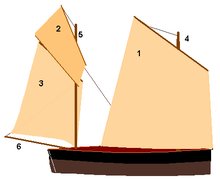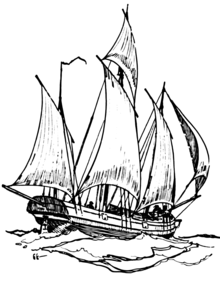Logger (ship type)

Logger (also Lugger or Lougre) originally referred to a historical type of ship from the 18th century with a wide variety of uses, later also a related type of fishing boat on the North Sea.
In the 18th century
The logger of the 18th century was used as fast mail, pirate, pilot or coastal cargo ships. In fishing, the "Lougre" or "Chasse Marée" (German: "Tides-Jäger") was used by the French channel fishermen for their Icelandic fisheries.
Typically the logger was three masted , the two front masts were foldable and the small mizzen mast was set extremely far back. The logger was equipped with so-called lug sails on all three masts, the (upper) spars of which were attached to the mast for about a third of their length. On the surface, the lug sail resembles a square sail , but in contrast to this, it lies alongside the ship in the rest position. It belongs (like the gaff or latin sail ) to the Schrat sails that enable sailing on the wind .
The fishing logger

In the 19th century the fishing logger, which is widespread in the North Sea region , emerged from this . In 1866, the Dutch shipowner Adrien Eugène Maas came to the conclusion that the fast French loggers for herring fishing with the herring drifting nets would be better suited than the comparatively slow and sluggish buisen and hoekers that were used up to now . He bought a three-masted logger in Boulogne-sur-Mer and had it start herring fishing as Scheveningen SN 1 from Vlaardingen . Due to good fishing success, he had two more loggers built in Vlaardingen the following year, the Hollander and the Arnoldine Marie . The ships were 17 m long and 5.55 m wide and had a draft of 2.40 m . The sails were completely changed: the ship was now rigged like a ketch , namely two-masted with a main mast and a much smaller mizzen mast set far to the rear, each with gaff sails and triangular or square big top or mizzen sails. It was suggested that this type of fishing vessel be called the “Maaskutter”, but this did not succeed. Instead, the name “Logger” remained, although this ship has little in common with the French Lougre other than its origin. In England, loggers replaced older types of fishing vessels such as the Brighton Hog-boat .
